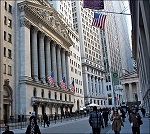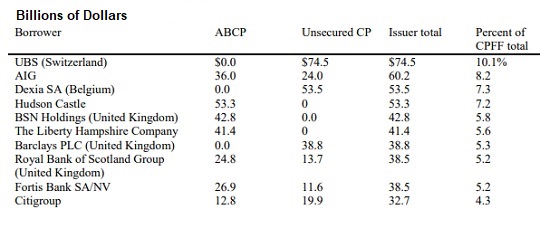By Pam Martens and Russ Martens: March 19, 2020 ~
 U.S. Treasury Secretary Steve Mnuchin and Wall Street pundits are all over cable news, repeating the mantra that “this is nothing like the last financial crisis,” while seeking to lay the blame for all of the newly-announced bailout measures for Wall Street at the feet of the coronavirus. But in terms of Wall Street privatizing profits and socializing losses, this is exactly like the last financial crisis.
U.S. Treasury Secretary Steve Mnuchin and Wall Street pundits are all over cable news, repeating the mantra that “this is nothing like the last financial crisis,” while seeking to lay the blame for all of the newly-announced bailout measures for Wall Street at the feet of the coronavirus. But in terms of Wall Street privatizing profits and socializing losses, this is exactly like the last financial crisis.
Wall Street’s crisis has a specific launch date: September 17, 2019. That’s when the Fed, for the first time since the last financial crisis, began dumping hundreds of billions of dollars a week into Wall Street’s trading houses. That program, called “repo loans,” now tallies up to more than $9 trillion in cumulative loans made to Wall Street at super-cheap borrowing rates. The first article we wrote on that Fed program was dated September 18, 2019 and titled: The Fed Intervened in Overnight Lending for First Time Since the Crash. Why It Matters to You.
September 17 was almost four months before the first death from coronavirus was reported in China on January 11, 2020 and five months before the first death was reported on February 28, 2020 in the U.S. (See the New York Times coronavirus timetable here.)
One half hour before midnight yesterday, the Federal Reserve Board of Governors quietly rolled out one more in a string of bailout measures it has been announcing since Sunday night to deal with Wall Street’s decade long gorging on speculative debt, derivatives, stock buybacks, obscene pay, and its serial crime spree. Each one of these Fed programs is identical, or almost identical, to the programs the Fed operated during the 2007-2010 financial crisis. If this were truly “nothing like” the last financial crisis, why would the Fed be using the identical measures to try to stem the crisis? The truth is that Wall Street is not going to let a national emergency go to waste. It’s going to maximize bailing itself out while the public’s attention is focused on a national crisis. (See The Untold Story of 9/11: Bailing Out Alan Greenspan’s Legacy.)
The latest Wall Street bailout program rolled out by the Fed last night is called the Money Market Mutual Fund Liquidity Facility and will purchase “unsecured and secured commercial paper” from money market funds, ostensibly to keep their market value from dropping inside the money market fund and the fund’s value from “breaking a buck,” meaning investors would get back less principal than they put in. It is rare for a money market fund in the U.S. to “break a buck,” meaning to trade below $1.00 per share. Several large funds broke a buck during the last financial crisis of 2007-2010 and set off a run on money market funds. The Fed created a very similar facility to the current one during that period – the Asset-Backed Commercial Paper Money Market Mutual Fund Liquidity Facility (AMLF) which ran from September 19, 2008 through February 1, 2010. Just as then, the Fed is allowing “branches and agencies of foreign banks” to borrow under the program as well as Wall Street banks and their trading units.
This marks the fourth reincarnation of facilities created during the Wall Street crisis of 2007-2010 by the Federal Reserve. The first was the repo loan program described above. On Tuesday, the Fed said it was creating the Commercial Paper Funding Facility (CPFF) and the Primary Dealer Credit Facility (PDCF). Both facilities operated during the last financial crisis. This time around, the Fed said that both programs would “support the flow of credit to households and businesses.”
But this is how the in-depth study done by the Levy Economics Institute described the operations of the CPFF the last time around:
“A total of 120 unique institutions took part in this facility. The top ten borrowers (each borrowing in excess of $20 billion) account for 64.3 percent ($473.9 billion) of all borrowing…The cumulative total lent under the CPFF was $737.07 billion. Peak lending occurred during the first week of operations [beginning October 7, 2008] at $144.59 billion, and the largest amount outstanding occurred on January 22, 2009 at $348.176 billion.” The CPFF was terminated on February 1, 2010.
Unfortunately, there is scant evidence that the CPFF helped U.S. households and businesses. According to the study done by Levy Economics Institute, the largest benefactors were foreign banks and the sinking hulk of the giant insurer, AIG, which had turned itself into Wall Street’s mistress by serving as the counterparty to Wall Street’s high risk derivatives without reserving for losses. (AIG was seized by the U.S. government on September 16, 2008 and backstopped with $185 billion in government support.) It has returned since to being a publicly-traded company; it still has significant exposure to Wall Street’s derivatives; and its shares have been tanking.
The fourth largest borrower under the CPFF was Hudson Castle, a firm that the New York Times described as the “alter ego” of Lehman Brothers which was used to “shift investments off its books.” Lehman Brothers collapsed and filed bankruptcy on September 15, 2008.

Top Ten CPFF Borrowers from October 7, 2008 through February 1, 2010. Source: Levy Economics Institute Using Federal Reserve Data
The PDCF was even worse at not helping American households or small businesses and it was exponentially larger than the CPFF. Read our full report from yesterday here.

